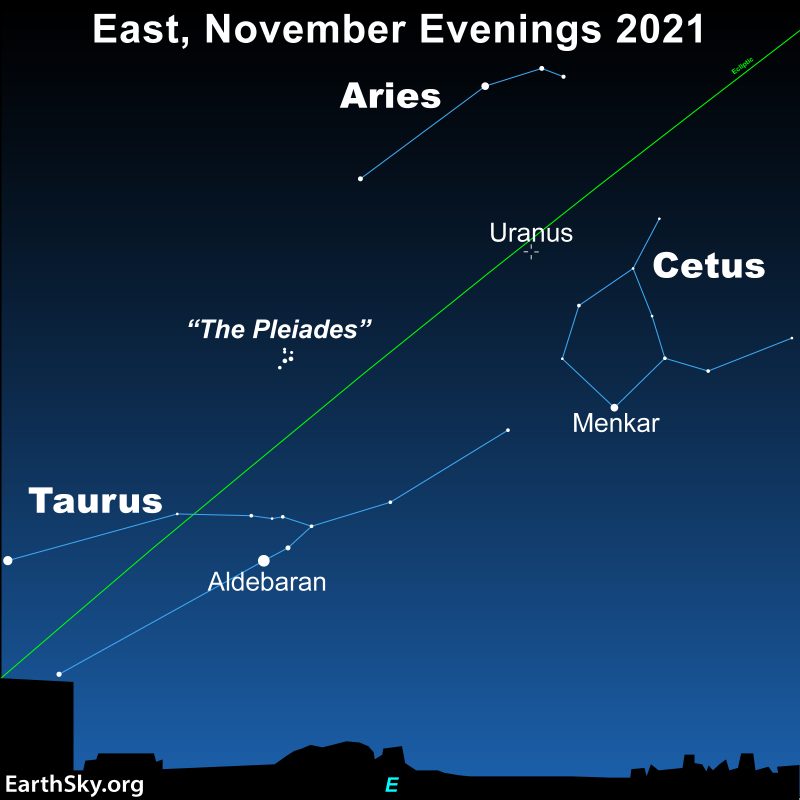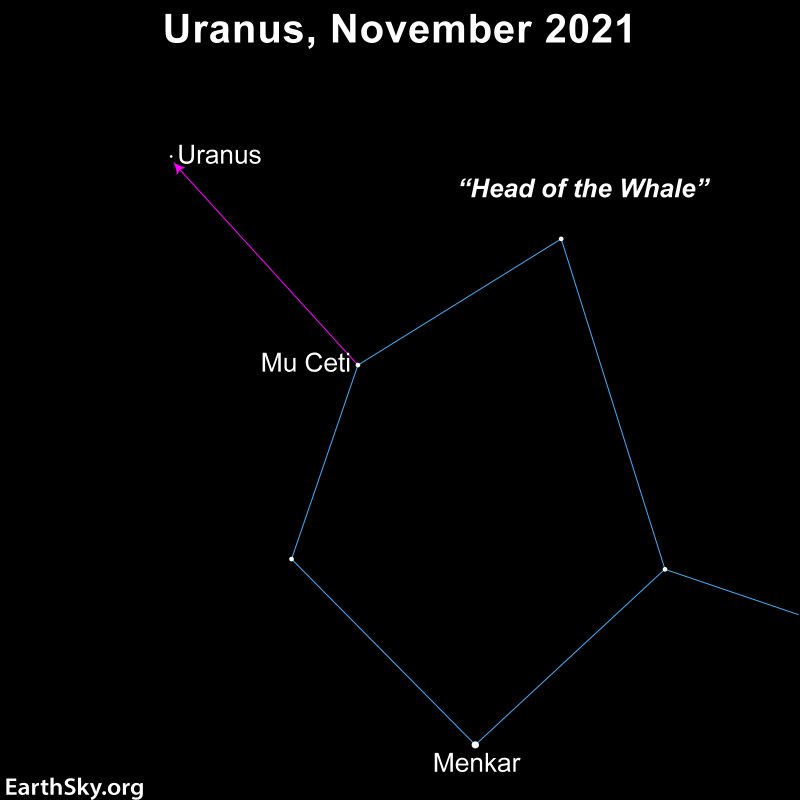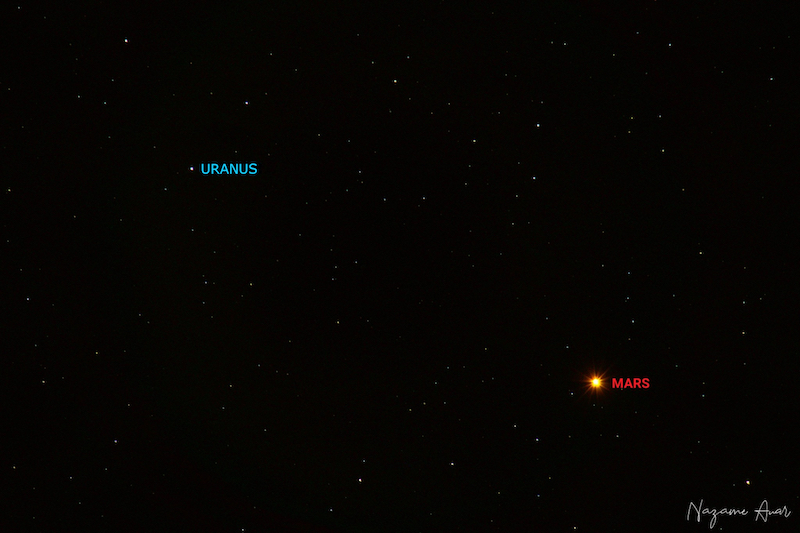
Uranus at opposition
Our planet Earth swings between the sun and Uranus on November 4-5, 2021, placing us squarely in the middle of the best time of year to see this outer planet. Why? Because in early November 2021, Uranus is opposite the sun in our sky. It rises in the east as the sun sets in the west. Astronomers say that Uranus reaches its yearly opposition.
Because Uranus is opposite the sun in early November 2021, it climbs highest up for the night at midnight (midway between sunset and sunrise). So Uranus stays out all night long. Also, around the time of opposition, Earth’s motion brings Uranus closest to Earth for 2021. The planet shines at its brightest in our sky. How bright is that? Not very bright.
The fact is, even at its brightest, Uranus is still quite faint. It’s barely perceptible as a dim speck of light to the unaided eye, even under dark skies. At a magnitude 5.6, Uranus shines no more brilliantly than the sky’s faintest visible stars. Given a dark sky free of light pollution, you might see Uranus with the eye alone. But you’ll need to know right where to look for this distant world in front of the rather faint constellation Aries.
New moon enhances view of Uranus at opposition
Fortunately for observers, the new moon – when the moon appears close to the sun in our sky and therefore is not in the night sky – falls on November 4, 2021, too. The moon turns new at 21:14 UTC on this date. Without a moon in the sky, there will be no bright moonlight to wash out fainter background stars and planets such as Uranus. Darker skies mean you have a better chance to spot dim objects.
A bonus for 2021 is that the date of opposition is right around the peak of the South Taurid meteor shower. While you’re out hunting down Uranus, you have the opportunity to catch a meteor or two.


Use the Whale to star-hop to Uranus
While Uranus is tough to spot with your eyes alone, it’s easy to view with binoculars. That is, if you know exactly where to look. Uranus is difficult to distinguish from a faint background star. You probably need a telescope to pick out its disk shape (remember, only stars are pinpoints). But binoculars should enhance its color; it shines with a greenish-blue hue.
Your best bet is to find a good sky chart and then star-hop from the 4.2-magnitude star Mu Ceti. Mu Ceti is a star in Cetus the Whale that is just across the border with Aries and Uranus. See the charts above.
Menkar is the brightest star in the circle and closest to the horizon. The star in the 10 o’clock position in the circle is Mu Ceti, the closest of the circle stars to Uranus. Uranus is 5 degrees (or 3 fingers held at arm’s length) to the upper left, or northwest, of Mu Ceti.


Distance to Uranus
At its closest point to Earth, Uranus is still twice as far away from us as its next-door neighbor, Saturn. At opposition, Uranus will be just shy of 19 astronomical units (AU) away from Earth and 20 AU from the sun. (By the way, one astronomical unit equals the distance of Earth from the sun). Visit Heavens-Above to find out the present distance of Uranus and the other solar system planets.
Other Uranus observing opportunities
While opposition is mathematically the best time to view Uranus due to its nearness and brightness, another great opportunity is when the dim planet is near a brighter, closer planet. For example, when Venus or Mars pass close to distant Uranus as seen from our point of view, we get an easy guidepost to point us to the gas giant.

In 2022, Venus passes a little more than 2 degrees from Uranus in June before sunrise. Then at the end of July and beginning of August, Mars passes a little more than 1 degree from Uranus in the early morning hours. Even Mercury gets within 2 degrees of Uranus on the dome of our sky, this time in April and in the evening. However, this meeting occurs not long after sunset and close to the horizon, making it more challenging overall.
Bottom line: Uranus reaches opposition on November 4, 2021, in the constellation Aries. The new moon also falls on November 4, providing dark skies for viewers.
The post Uranus at opposition November 4 first appeared on EarthSky.
from EarthSky https://ift.tt/3mJnoDt

Uranus at opposition
Our planet Earth swings between the sun and Uranus on November 4-5, 2021, placing us squarely in the middle of the best time of year to see this outer planet. Why? Because in early November 2021, Uranus is opposite the sun in our sky. It rises in the east as the sun sets in the west. Astronomers say that Uranus reaches its yearly opposition.
Because Uranus is opposite the sun in early November 2021, it climbs highest up for the night at midnight (midway between sunset and sunrise). So Uranus stays out all night long. Also, around the time of opposition, Earth’s motion brings Uranus closest to Earth for 2021. The planet shines at its brightest in our sky. How bright is that? Not very bright.
The fact is, even at its brightest, Uranus is still quite faint. It’s barely perceptible as a dim speck of light to the unaided eye, even under dark skies. At a magnitude 5.6, Uranus shines no more brilliantly than the sky’s faintest visible stars. Given a dark sky free of light pollution, you might see Uranus with the eye alone. But you’ll need to know right where to look for this distant world in front of the rather faint constellation Aries.
New moon enhances view of Uranus at opposition
Fortunately for observers, the new moon – when the moon appears close to the sun in our sky and therefore is not in the night sky – falls on November 4, 2021, too. The moon turns new at 21:14 UTC on this date. Without a moon in the sky, there will be no bright moonlight to wash out fainter background stars and planets such as Uranus. Darker skies mean you have a better chance to spot dim objects.
A bonus for 2021 is that the date of opposition is right around the peak of the South Taurid meteor shower. While you’re out hunting down Uranus, you have the opportunity to catch a meteor or two.


Use the Whale to star-hop to Uranus
While Uranus is tough to spot with your eyes alone, it’s easy to view with binoculars. That is, if you know exactly where to look. Uranus is difficult to distinguish from a faint background star. You probably need a telescope to pick out its disk shape (remember, only stars are pinpoints). But binoculars should enhance its color; it shines with a greenish-blue hue.
Your best bet is to find a good sky chart and then star-hop from the 4.2-magnitude star Mu Ceti. Mu Ceti is a star in Cetus the Whale that is just across the border with Aries and Uranus. See the charts above.
Menkar is the brightest star in the circle and closest to the horizon. The star in the 10 o’clock position in the circle is Mu Ceti, the closest of the circle stars to Uranus. Uranus is 5 degrees (or 3 fingers held at arm’s length) to the upper left, or northwest, of Mu Ceti.


Distance to Uranus
At its closest point to Earth, Uranus is still twice as far away from us as its next-door neighbor, Saturn. At opposition, Uranus will be just shy of 19 astronomical units (AU) away from Earth and 20 AU from the sun. (By the way, one astronomical unit equals the distance of Earth from the sun). Visit Heavens-Above to find out the present distance of Uranus and the other solar system planets.
Other Uranus observing opportunities
While opposition is mathematically the best time to view Uranus due to its nearness and brightness, another great opportunity is when the dim planet is near a brighter, closer planet. For example, when Venus or Mars pass close to distant Uranus as seen from our point of view, we get an easy guidepost to point us to the gas giant.

In 2022, Venus passes a little more than 2 degrees from Uranus in June before sunrise. Then at the end of July and beginning of August, Mars passes a little more than 1 degree from Uranus in the early morning hours. Even Mercury gets within 2 degrees of Uranus on the dome of our sky, this time in April and in the evening. However, this meeting occurs not long after sunset and close to the horizon, making it more challenging overall.
Bottom line: Uranus reaches opposition on November 4, 2021, in the constellation Aries. The new moon also falls on November 4, providing dark skies for viewers.
The post Uranus at opposition November 4 first appeared on EarthSky.
from EarthSky https://ift.tt/3mJnoDt

Aucun commentaire:
Enregistrer un commentaire